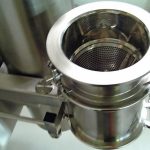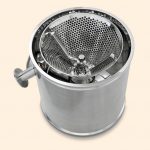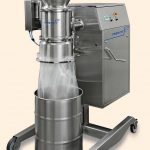The time is half past eight on a Monday morning at Route du Coteau 7 in Granges-Paccot. The telephone rings. One hour later a Frewitt service technician is at the customer’s site. The distance from Fribourg (Switzerland) is about thirty minutes by car. Yet, this is not the only reason why the pharmaceutical manufacturer chose Frewitt mills when adapting the milling process to Atex regulations.
Plant engineering accompanied right from the beginning
Why certain mills simply mill better
The time is half past eight on a Monday morning at Route du Coteau 7 in Granges-Paccot. The telephone rings. One hour later a Frewitt service technician is at the customer’s site. The distance from Fribourg (Switzerland) is about thirty minutes by car. Yet, this is not the only reason why the pharmaceutical manufacturer chose Frewitt mills when adapting the milling process to Atex regulations.
Just like a racing car, no machine can run for long without a mechanic. Constant adjustments and optimisations to take account of changing conditions are an everyday occurrence, often paving the way for the installation of new systems or devices. The aforementioned manufacturer specialises in medicines to strengthen the immune system. Amongst other things, the milling process for this purpose had to be made Atex compliant. Frewitt, already a familiar name to many people at the company, was invited to a meeting, during which it quickly became apparent that rebuilding the existing mills would not make business sense. A cheaper and more reliable solution was therefore put forward: to replace the TC mills with the latest generation of sieve mills. First of all, various customer products were tested on a Coniwitt-200 at Frewitt’s Technical Center, in order to avoid the costs for a second validation of the new mills. Since the type of construction and mesh width of the earlier TC generation have been retained by Frewitt, and the particle distribution of the milled products on the Coniwitt-200 remains identical with that of the TC, the customer was able to dispense with re-validation while reaping all the advantages of the new ConiWitt series. Two Atex compliant Coniwitt-200 sieve mills were selected to take over from two older TC-200 models.
Easy to clean
Although the design of the sieves and the milling results are identical, the effects of the new Coniwitt concept are clearly felt in production. The sieve mill has a monobloc design and dead space-free geometry, with a reputation among customers for easy cleaning. The milling head, too, is one-piece with electropolished surfaces. It can be exchanged and installed by the operator very simply with the help of the drive arm. All product contacting parts and surfaces are made of stainless steel (AISI 316) and sealed against the milling chamber with an FDA approved O-ring. Furthermore, the transition points between the rotor and the shaft, the sieve and the bearing head, and the conical sieve insert and the housing are completely sealed. The ConiWitt is thus suitable for low-grade pathogenic or sterile processes, having successfully passed the riboflavin test.
One aspect that was particularly important to the customer is the fact that, due to the new design, no friction is created between the sieve and the rotor. This prevents unnecessary heating of the product. As an additional benefit, the high throughput – up 25 % – significantly accelerates the return on investment.
Safety and control elements
Several key elements enable intervention in the process at any time in the interests of optimal safety and control. Every Coniwitt is shipped with a process display as well as start, stop and emergency stop switches. The speed can be varied continuously from 300 to 1800 min-1 using a frequency converter. Formulas can be generated, alarms diagnosed and processes stored on a Siemens PLC. The mobile version mounted on antistatic rollers is Atex compliant. The milling chamber conforms to Atex II 2D (zone 21) while the other sieve mill components have Atex II 3D certification (zone 22).
Certain corrections and adaptations are always necessary and this project was no exception. The base frame had to be specially lowered to avoid any conflict with the connection dimensions of the old machine. The infeed hopper is slightly larger than the standard size. And when it came to the final acceptance test at Frewitt, the customer insisted on being provided with supplementary documents.
Hall 1, Booth 343
www.cpp-net.com search: cpp0116frewitt
Share:










